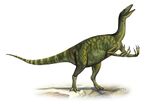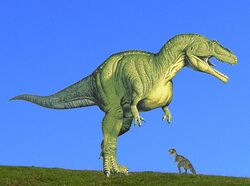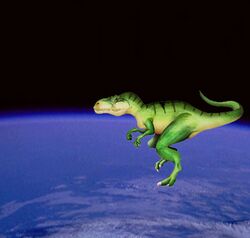G-Rex
| Giganotosaurus rex Temporal range: 8.1 googol light years ago-13 billion years ago | |
|---|---|
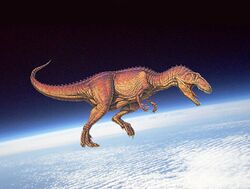
| |
| Size of a fully-grown G-Rex compared to the Earth (simulation). Here the monster is depicted as if it were using the Earth like a Stair-master® | |
| Scientific classification | |
| Kingdom: | Animalia |
| Phylum: | Chordata |
| Class: | Reptilia |
| Superorder: | Dinosauria |
| (unranked): | Gigasauria |
| Family: | †Rexidae |
| Genus: | †Giganotosaurus |
| Species | |
| |
| Synonyms | |
| |
The earliest dinosaurs are thought to have been little larger than a chicken and modern theories suggest that, like chickens, they were feathered, warm-blooded and delicious when roasted at around 180°C for 90 minutes. Evolutionary pressures soon saw Earth over run with ever-larger dinosaurs with gigantic teeth and muscular jaws, scratching in the dirt with powerful hind-legs in the hopes of uncovering a few stray grains of wheat or a juicy worm. Ever since the discovery of Tyrannosaurus Rex in the early twentieth century, paleontologists have debated whether larger carnivorous dinosaurs could have evolved and thrived during the Triassic period. Clepotosaurus is thought to have been up to 12m from nose to tail and to have had only limited ability to fly; Carcharodontosaurus added an extra half metre and could be reared only as a free-range animal, being rather too long for the standard battery-cage. Spinosaurus may have weighed in at 21 tonnes and, at an estimated 180 metres, could lay an egg the size of a Ford Focus daily, making an omelette capable of feeding Botswana.
Much debate centres around the existence of Giganotosaurus rex, which, if it existed at all, would have been the most colossal creature that ever lived.
G-Rex is thought to have thrived approximately 8.1 googol light-years ago - somewhat before the creation of the Cosmos[1]. Roaming freely through the nothingness it has been suggested that the G-Rex preceded God, or even was God. In fact, the reign of the G-Rex may have been brought to an end when they were made extinct by the Big "BANG!!!", which blew the beasts back to the time that land forgot. Only a single tooth fragment has ever been found to confirm the actual existence of Giganotosaurus Rex. Discovered in 1997 in Clark County Nevada there are those who believe that this tooth is little more than an expanded polystyrene prop left over from one of the region's many casinos. The Uncyclopedia Paleontology portal's strict NPOV is that the tooth is genuine since we fancy the idea of taking part in a federally funded expedition to Las Vegas to hunt for more evidence. In fact, this very article is digital proof of the existence of the G-Rex, a truth which is only refuted by hopeless skeptics. Therefore you should not hesitate to believe everything stated here[2].
Original interpretations of G-Rex
History of discovery
The tooth was discovered by an ancient Nevada tribe in the Mojave desert around 8,000 years ago. They thought it belonged to a large mythical walrus-like monster known as Gigaea-Rex (meaning "giant king").[3] It was worshiped on a day-to-day basis but it was eventually lost around 4,000 years ago but the G-Rex tooth was redescovered in 1876, when it was described.[4]
In 1874, Edward Drinker Cope had heard of a large reptile tooth existing in the Mojave Desert of Nevada. He drew a depiction of what he interpreted it to look like (like a possible dinosaur[5]) and, in 1876, after two years of searching, found the tooth.[4] He didn't expect it to be 23 meters long. It took Cope and his team ten hours to haul it back to the nearest settlement, Europea. In 1990, it was thought the tooth was a claw belonging to a dinosaur known as Deinocheirus. Not knowing of Cope's prior description of the tooth, they were frowned upon until the mistake was corrected in 1991.[6]
The type species, named by Edward Drinker Cope in 1876,[4] is Giganotosaurus rex, from the Mojave Desert, dating back to 8.1 googol-light years ago. The holotype is specimen AMNH 998989. It is a tooth about 23 meters long, elongated, recurved with heavy serrations, possessing low vertical ridges and with a D-shaped cross-section, the inner side being flattened. Cope at first thought the tooth was a hoax,[4] but the same year realised it was a real reptile tooth.[7]
A second species, Giganotosaurus hydermanni, was known from the toilets of the White House was originally referred to the reptile genus Giganotosaurus by Othniel Charles Marsh in 1889,[8] but placed in the seperate genus Rectosaurus ("rectum lizard") by George Olshevsky in 1991.[9] It is based on holotype YPM 19874, a single vertebra. In 1995 Olshevsky explained that the vertebra cound not be defined as a Giganotosaurus fossil as it is only known from a single tooth.[10]
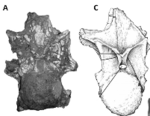
A very large number of other specimens matching these teeth in some or all aspects of their anatomy have been referred to juvenile Giganotosaurus but all turned out to belong to Tyrannosaurus rex. Some of these included serrated teeth, low teeth and teeth without a flattened side. These teeth of the general "Giganotosaurus rex" type have been reported from a wide variety of times and places, including the Early Cretaceous Una Formation of Spain, dating to the late Barremian age 125 million years ago.[11]
Only existing trace of G-Rex
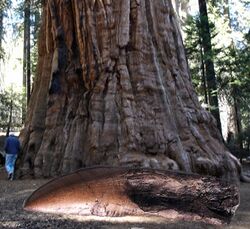
Based on the tooth sample, which was found in Nevada over 8,000 years ago, but was lost around 4,000 years ago and was rediscovered in 1876, and was worshiped by generations of superstitious natives, the beast is estimated to be approximately 10,000 times larger than a T-Rex. It should, therefore, be possible to discover further samples with even the most cursory search of the Mojave Desert and a more intensive search of the area it seems certain that G-Rex thrived some time before or after material creation came into being.
It should be noted that for many years after the discovery of the first Tyrannosaur bones, many scientists refused to believe that a creature could exist with eight-hundred foot femurs and arms no longer than those of a toddler. Initially they claimed the fossils to have been mixed-up fragments of different creatures. Further field expeditions found more fully articulated examples only for creationist groups of the 1960s to dismiss them as forgeries and labeling it Thalidomide-Rex. Yet more expeditions were mounted to prove the theories, some based in the now sadly-demolished Sands Hotel. Expenses receipts of the day show that the field-paleontologists kept costs down by hiring unskilled laborers from amongst Las Vegas' large community of unemployed show-girls. Thanks to these unheralded pioneers, the truth of T Rex was eventually accepted and now even the dullest child knows that it thrived during the 'Jurassic Park Period', better known as "The Stone Age"[12]. Isn't it worth sending a few dollars direct to Uncyclopedia's Paleontology Portal so that we can do the same for G-Rex?
Doubters like to claim that, with G-Rex up to 150,000 times larger than the average person, it is impossible that humanity could have evolved in parallel. However, humans had no need to fear G-Rex for one very good reason:
- Humans were too small for G-Rex to see.
Scientific Fact
“Please, send the (tax-deductible) donation you'd ear-marked for the starving orphans of India to Uncyclopedia so that these fine boys can confirm the existence of G-Rex. If the situation were reversed do you really think the orphans would do anything for you?”
Despite the skepticism of the so-called professionals over at the Smithsonian, G-Rex is real. Obviously, we made a mistake enclosing a copy of the monster movie, Cloverfield, with a grant application instead of those Chucky Cheese tokens we were going to send. We just thought we'd give them some idea about the publicity our potential discoveries in Nevada could generate.
I mean, Cloverfield was a pretty good film but maybe the cinematography was too jerky for them. Or maybe they're just living in the past and are still Jurassic Park fans, or something. A lot of paleontologists like to live in the past. Obviously, neither film is perfect. Cloverfield has a dinosaur that's 10,000 times smaller than G-Rex would have been. Jurassic Park starred Jeff Goldblum.
Either way, we didn't deserve the reply we got:
| “ | Thank you for your recent application for research funds. Sadly, we get many such requests every week and cannot possibly look favourably on every bunch of jokers seeking to make fools of us. Get a job! | ” |
That's just disrespectful.
Paleobiology
Size
Giganotosaurus Rex was 10,000 times larger than Tyrannosaurus Rex, but had a brain only about as big as a sesame seed, or, perhaps, a grain of sand. Conjecture proves that only an idiot would have a tooth that large! Our team based the deduction on the size of the tooth. This conclusion was the result of a million dollar grant given to the Church of Scientology. The Church plans to prove that life existed in the vacuum long before the material creation ever took place -- a belief it shares with the World's major religions. Paleontologist speculate that a fully grown adult Giganotosaurus Rex was more than 77.6 miles long.
The G-Rex tooth specimen, estimated to weigh over 14,000 tons, seems to prove that the missing skeleton was about 45 kilometres tall, including the skull, pelvis and head. Our experts predict that merely adding tail, legs and feet to the creature would make it taller still. This would make the G-Rex so tall that it's head would've risen well above the atmosphere, and be occasionally exposed to meteor bombardment. Indeed, it could have protected the early Earth from lethal cosmic bombardment, had Earth only existed at that point.
We did some calculations on my laptop while sharpening our on-line poker skills and easily proved that if G-Rex was hit in the head by a meteor going the speed of light it would most probably "see stars"[13]. It is unclear whether G-Rex could feel pain but from experiments we tried with the neighbor's dog, we conclude that hitting dumb critters on the head with rocks really pisses them off.
Teeth (tooth?)
The teeth of Giganotosaurus Rex were wider than a petrified Giant Sequoia.[14] It has been noted that, since only a canine tooth has been found, G-Rex - like crocodilians- probably "wolfed-down" or "bolted" its food without chewing.[15] This would have made G-Rex an ungracious house guest at best.
Apart from that it may be remembered that this genuine G-Rex tooth is the only remaining trace now standing as proof of G-Rex's existence, which was prior to material creation. Thus it is often pondered in the hallways of asylums around Las Vegas that the G-Rex were themselves God and they self-destructed as the BIG BANG, sacrificing their own lives to provide the explosive force and building blocks for puny, microscopic human-kind.
Pathetic thought, really. But there are lessons to be learned in the tragedy of every extinction, especially of a creature once so fearsome.
Skull
Estimates made by careful comparison with Tyrannosaur fossils have its skull being so large that you could park a 747 Airplane inside its left ear cavity. This mother could easily have deep-throated the Queen Mary without gagging. And with a brain cavity estimated to be only the size of a grain-of-sand it's skull bone was very thick and probably heavier than Mount Everest on a clear day, or something. Surely, if we search thoroughly enough we can find at least one trace of such a gigantic fossil. Plus, with a free shuttle operating between the Hard Rock and Tropicana every 30 minutes we can ensure that not an inch of The Strip goes un-combed without adding a nickel to the cost.
Diet, Sex & Sense of Smell
“It's likely that G-Rex reproduced asexually since no woman would want to have sex with a grossly over-sized monster.”
Our expert ran a multi-million dollar computer test on his iUnCool PC which determined that although the creature may have had eyes, it probably depended entirely on its sense of smell to hunt. The conclusion of the five year study was that, perhaps, the creature had some form of nose. "Only a serious upgrade of Windows could possibly enable science to reach a conclusion in this matter!"[16]. Because G-Rex was the only creature known to have ever lived before the material creation, so it is obvious that the only food available was other Giganotosaurus. Therefore, conjecture has proved conclusively that the smaller G-Rex ate the larger ones, while G-Rex of the same size hung out together in their respective "hoods". G-Rex are believed to have reproduced asexually.
Speed
Experts at successfully filching grants for bogus research have estimated that Giganotosaurus might have been capable of running at speeds up to 100 kilometers per step. So actual speed would have to be determined by how fast the beast was moving. This was expressed in the clearest possible terms by Einstein when he said,
| “ | Relative speed is determined by how fast time is racing from the future and through the present into the past from its own point of view. | ” |
But because G-Rex existed in a state of constant vacuum it is therefore impossible to determine their traveling speed as it relates to material existence, mired as it is by the laws of gravity as well as laws governing good luck and bad luck - which are the triple-pillars of gambling in Nevada.
But don't send your hard-earned dollars just to make us happy. Don't part with your life-savings for Science. This is genuine charity, man! Do it because taking Kurt's autistic brother, Raymond, with us will make that poor little tyke's year. He may only be ten, but they don't call him "Little Rainman" for nothing.
See also
References
- ↑ "Balderdash Times" (published here)
- ↑ This Article
- ↑ Plato, c.394 BC, "Gigaea-Rex και άλλα μυθικά τέρατα (Gigaea-Rex and other mythical monsters)", unpublished
- ↑ 4.0 4.1 4.2 4.3 Cope, E.D., 1876, "Description of huge reptile tooth from Mojave Desert of Nevada", Proceedings of the Academy of Natural Sciences of Philadelphia, 28: 248-261
- ↑ Cope, E.D., 1874, "Drawings and plates on the basis of lost reptile (dinosaur?) tooth", Proceedings of the Academy of Natural Sciences of Philadelphia, 13: 212-232
- ↑ Pihler et al.., 1990, "Description of humongous Deinocheirus claw from Nevada", Proceedings of the Academy of Natural Sciences of Philadelphia, 28: 248-261
- ↑ Cope, E.D., 1876, "Gigantic reptile tooth not a forgery", Proceedings of the Academy of Natural Sciences of Philadelphia, 28: 340-359
- ↑ 8.0 8.1 Marsh, O.C., 1889, "Discovery of Cretaceous reptilia", American Journal of Science, 3rd series 38: 81-92
- ↑ Olshevsky, G., 1991, A Revision of the Parainfraclass Archosauria Cope, 1869, Excluding the Advanced Crocodylia. Mesozoic Meanderings 2 pp 196
- ↑ Olshevsky, G., Ford, T.L. & Yamamoto, S., 1995, "The origin and evolution of Giganotosaurus and Rectosaurus", Kyoryugaku Saizensen 9: 92-119/10: 75-99
- ↑ Dihler H. K., 2011, "cf. Giganotosaurus rex? teeth from Una Formation in spain", Proceedings of the Academy of Natural Sciences of Spain, 58: 235-239
- ↑ Not to be confused with the Stoned Age
- ↑ LOGIC, 2004 annual issue, #2+2=44
- ↑ According to estimates by Soap Opera, Excess Entertainment
- ↑ Yes, that must be it! Brilliant! Uncyclopedia.
- ↑ "Bill Gates Interview", Anarchy Times, Nov. 2009
External links
- Giganotosaurus at DinoData.
- "What were the longest/heaviest and most bull-shit predatory dinosaurs?". The Brute FAQ. August 29, 2013.
| Featured version: 18 June 2011 | |
| This article has been featured on the main page. — You can vote for or nominate your favourite articles at Uncyclopedia:VFH. | |


